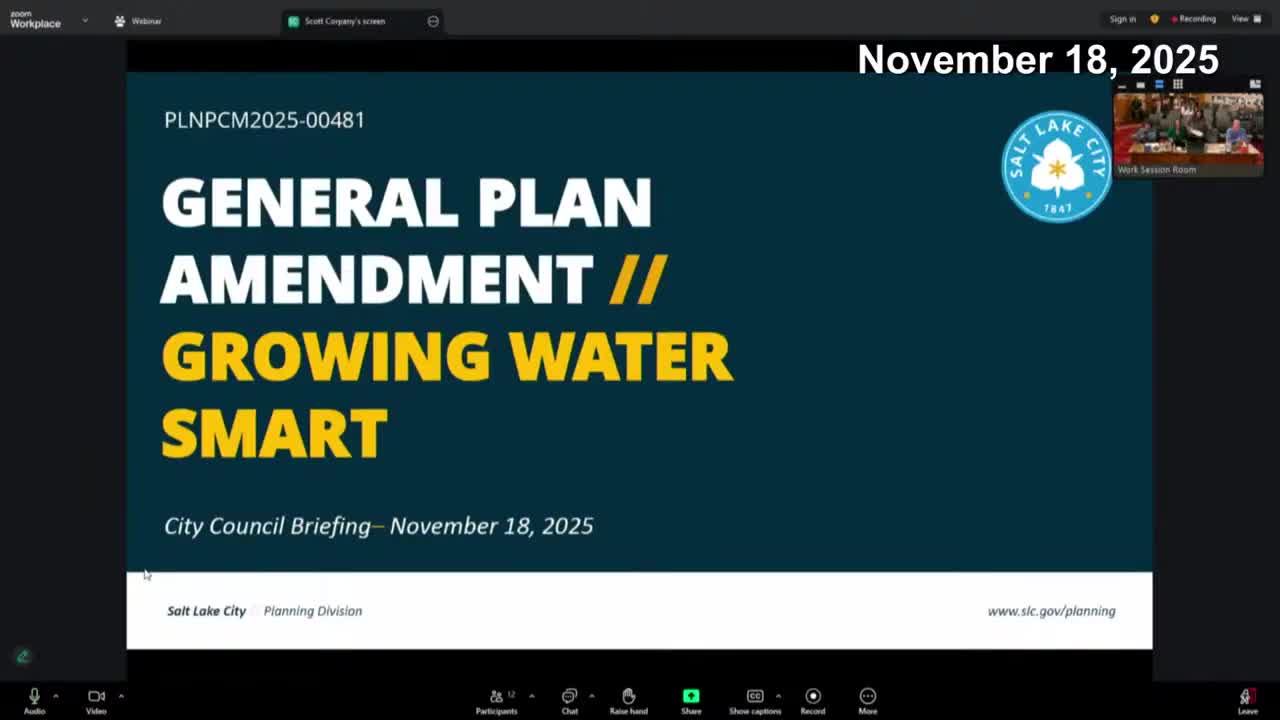Council reviews proposed Chapter 14 to link water conservation and land use; no numeric Great Salt Lake target set yet
November 19, 2025 | Salt Lake City, Salt Lake County, Utah
This article was created by AI summarizing key points discussed. AI makes mistakes, so for full details and context, please refer to the video of the full meeting. Please report any errors so we can fix them. Report an error »

Planning staff presented a proposed addition to Plan Salt Lake — Chapter 14, "Growing Water Smart" — designed to integrate land‑use planning with water conservation consistent with Utah state code requiring a water component in city general plans by year end.
Mikayla (planning staff), Laura Briefer (Salt Lake City Public Utilities), and Stephanie Dewar summarized six state‑required components: (1) aligned water supply and demand planning, (2) methods to reduce per‑capita water consumption, (3) water reductions in city operations, (4) alignment with regional conservation goals, (5) reference and update of existing water conservation plans, and (6) sustainable landscaping policies. Staff noted the city already reaches state conservation goals earlier than targets and recommended updating the supply and demand plan every five years or when conditions require.
Council questions and staff responses: Council members asked about embedding smart irrigation controllers into city and private standards and incentives. Stephanie and a Central Utah Water Conservancy District representative said there are rebates for EPA WaterSense‑labeled smart controllers and that outreach and a five‑year communication plan are part of implementation to increase participation among residential, commercial, and institutional customers. Staff also reported the city has amended landscaping standards recently to align with state rebates.
Great Salt Lake: Council members asked whether the amendment sets a quantitative target for water returned to the Great Salt Lake. Planning and utilities staff said no single citywide quantitative goal is set in the amendment; measurement is complex and the water supply & demand and conservation plans (statutorily directed) are the venues to develop measurable strategies with basin partners and the State Division of Natural Resources.
Why this matters: The chapter would codify the city's approach to conserving water as growth continues and to meet a statutory deadline. It could affect future land‑use designations, large‑water‑use prohibitions (e.g., bottling plants in the inland port were mentioned), and incentives for developments to reduce water demand.
Next steps: Staff said the water conservation plan update will be briefed next week and the proposed chapter will return to council for formal consideration; the state requires integration of the water element into the general plan before year end.
Mikayla (planning staff), Laura Briefer (Salt Lake City Public Utilities), and Stephanie Dewar summarized six state‑required components: (1) aligned water supply and demand planning, (2) methods to reduce per‑capita water consumption, (3) water reductions in city operations, (4) alignment with regional conservation goals, (5) reference and update of existing water conservation plans, and (6) sustainable landscaping policies. Staff noted the city already reaches state conservation goals earlier than targets and recommended updating the supply and demand plan every five years or when conditions require.
Council questions and staff responses: Council members asked about embedding smart irrigation controllers into city and private standards and incentives. Stephanie and a Central Utah Water Conservancy District representative said there are rebates for EPA WaterSense‑labeled smart controllers and that outreach and a five‑year communication plan are part of implementation to increase participation among residential, commercial, and institutional customers. Staff also reported the city has amended landscaping standards recently to align with state rebates.
Great Salt Lake: Council members asked whether the amendment sets a quantitative target for water returned to the Great Salt Lake. Planning and utilities staff said no single citywide quantitative goal is set in the amendment; measurement is complex and the water supply & demand and conservation plans (statutorily directed) are the venues to develop measurable strategies with basin partners and the State Division of Natural Resources.
Why this matters: The chapter would codify the city's approach to conserving water as growth continues and to meet a statutory deadline. It could affect future land‑use designations, large‑water‑use prohibitions (e.g., bottling plants in the inland port were mentioned), and incentives for developments to reduce water demand.
Next steps: Staff said the water conservation plan update will be briefed next week and the proposed chapter will return to council for formal consideration; the state requires integration of the water element into the general plan before year end.
View full meeting
This article is based on a recent meeting—watch the full video and explore the complete transcript for deeper insights into the discussion.
View full meeting

